Talent Management Strategies for Retention of Employees - A Case Study on Hotwire
VerifiedAdded on 2023/06/18
|14
|3132
|134
AI Summary
This research paper analyzes the talent management strategies for retention of employees in Hotwire. It includes a literature review on the importance of talent management, identification of talent management retention strategies, and evaluation of the best talent management strategy. The research methods used are qualitative research and data collection through primary and secondary sources. The outcomes of the research show that talent management strategies are helpful in retaining high-performing employees. The methods used to achieve objectives are data collection methods, and other methods that could have been used are not mentioned.
Contribute Materials
Your contribution can guide someone’s learning journey. Share your
documents today.
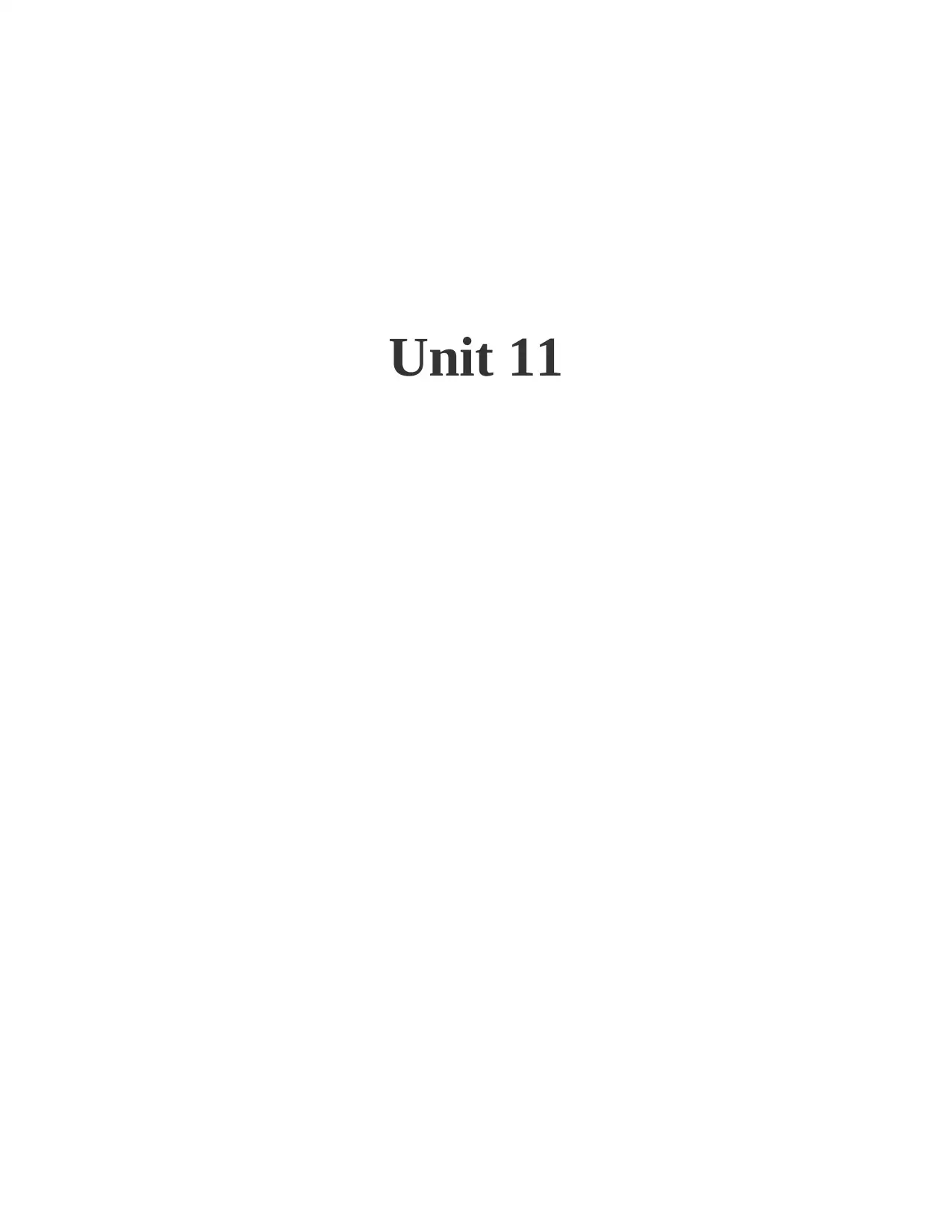
Unit 11
Secure Best Marks with AI Grader
Need help grading? Try our AI Grader for instant feedback on your assignments.
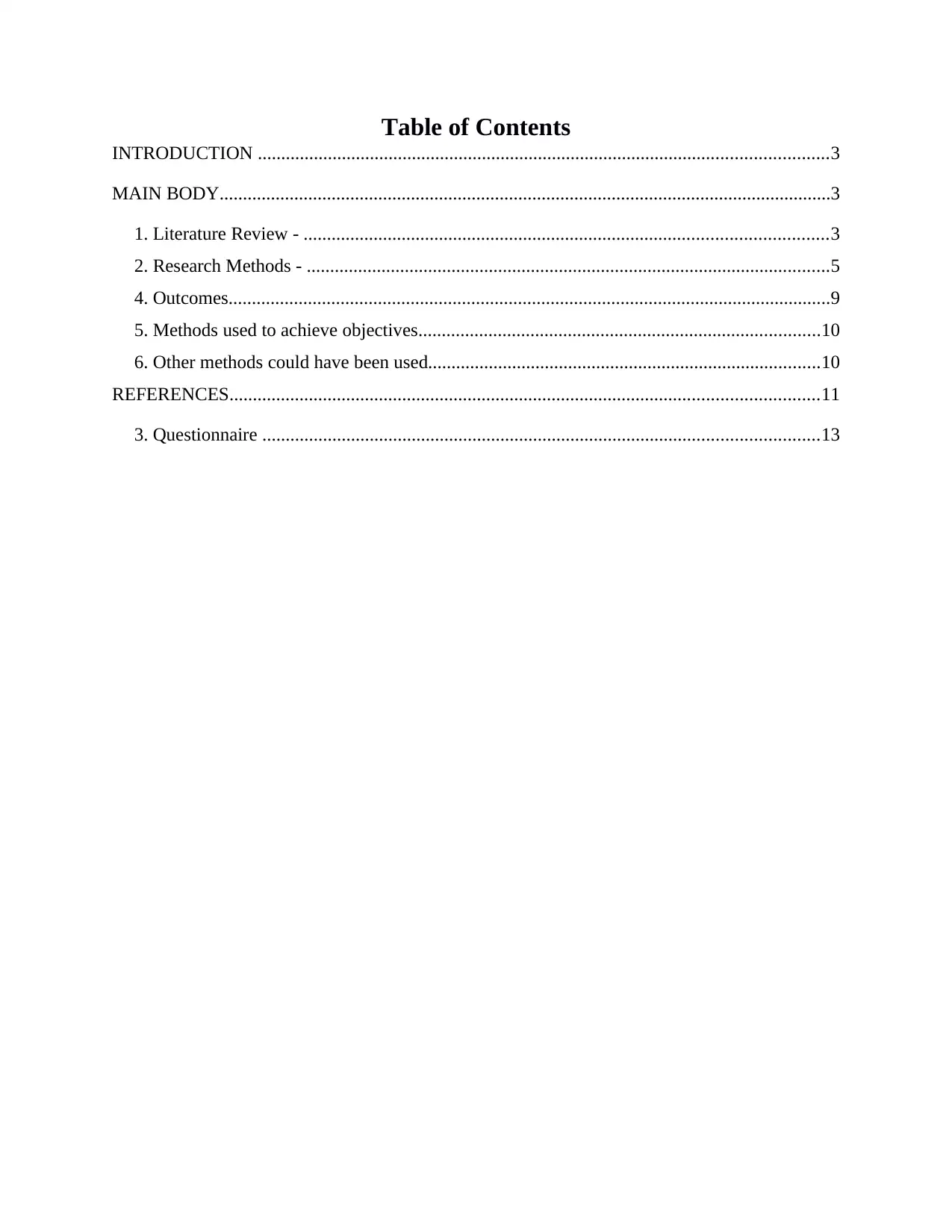
Table of Contents
INTRODUCTION ..........................................................................................................................3
MAIN BODY...................................................................................................................................3
1. Literature Review - ................................................................................................................3
2. Research Methods - ................................................................................................................5
4. Outcomes.................................................................................................................................9
5. Methods used to achieve objectives......................................................................................10
6. Other methods could have been used....................................................................................10
REFERENCES..............................................................................................................................11
3. Questionnaire .......................................................................................................................13
INTRODUCTION ..........................................................................................................................3
MAIN BODY...................................................................................................................................3
1. Literature Review - ................................................................................................................3
2. Research Methods - ................................................................................................................5
4. Outcomes.................................................................................................................................9
5. Methods used to achieve objectives......................................................................................10
6. Other methods could have been used....................................................................................10
REFERENCES..............................................................................................................................11
3. Questionnaire .......................................................................................................................13
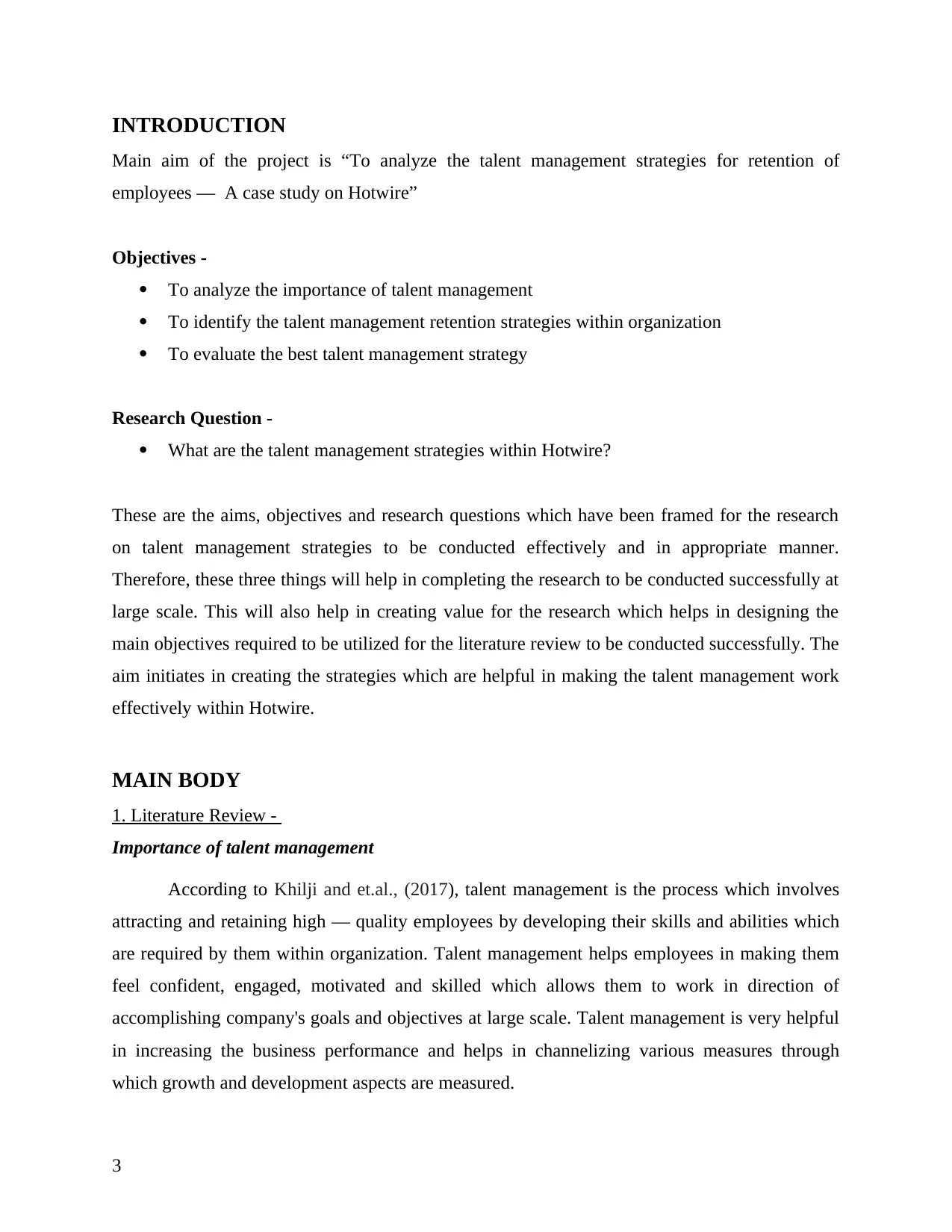
INTRODUCTION
Main aim of the project is “To analyze the talent management strategies for retention of
employees — A case study on Hotwire”
Objectives -
To analyze the importance of talent management
To identify the talent management retention strategies within organization
To evaluate the best talent management strategy
Research Question -
What are the talent management strategies within Hotwire?
These are the aims, objectives and research questions which have been framed for the research
on talent management strategies to be conducted effectively and in appropriate manner.
Therefore, these three things will help in completing the research to be conducted successfully at
large scale. This will also help in creating value for the research which helps in designing the
main objectives required to be utilized for the literature review to be conducted successfully. The
aim initiates in creating the strategies which are helpful in making the talent management work
effectively within Hotwire.
MAIN BODY
1. Literature Review -
Importance of talent management
According to Khilji and et.al., (2017), talent management is the process which involves
attracting and retaining high — quality employees by developing their skills and abilities which
are required by them within organization. Talent management helps employees in making them
feel confident, engaged, motivated and skilled which allows them to work in direction of
accomplishing company's goals and objectives at large scale. Talent management is very helpful
in increasing the business performance and helps in channelizing various measures through
which growth and development aspects are measured.
3
Main aim of the project is “To analyze the talent management strategies for retention of
employees — A case study on Hotwire”
Objectives -
To analyze the importance of talent management
To identify the talent management retention strategies within organization
To evaluate the best talent management strategy
Research Question -
What are the talent management strategies within Hotwire?
These are the aims, objectives and research questions which have been framed for the research
on talent management strategies to be conducted effectively and in appropriate manner.
Therefore, these three things will help in completing the research to be conducted successfully at
large scale. This will also help in creating value for the research which helps in designing the
main objectives required to be utilized for the literature review to be conducted successfully. The
aim initiates in creating the strategies which are helpful in making the talent management work
effectively within Hotwire.
MAIN BODY
1. Literature Review -
Importance of talent management
According to Khilji and et.al., (2017), talent management is the process which involves
attracting and retaining high — quality employees by developing their skills and abilities which
are required by them within organization. Talent management helps employees in making them
feel confident, engaged, motivated and skilled which allows them to work in direction of
accomplishing company's goals and objectives at large scale. Talent management is very helpful
in increasing the business performance and helps in channelizing various measures through
which growth and development aspects are measured.
3
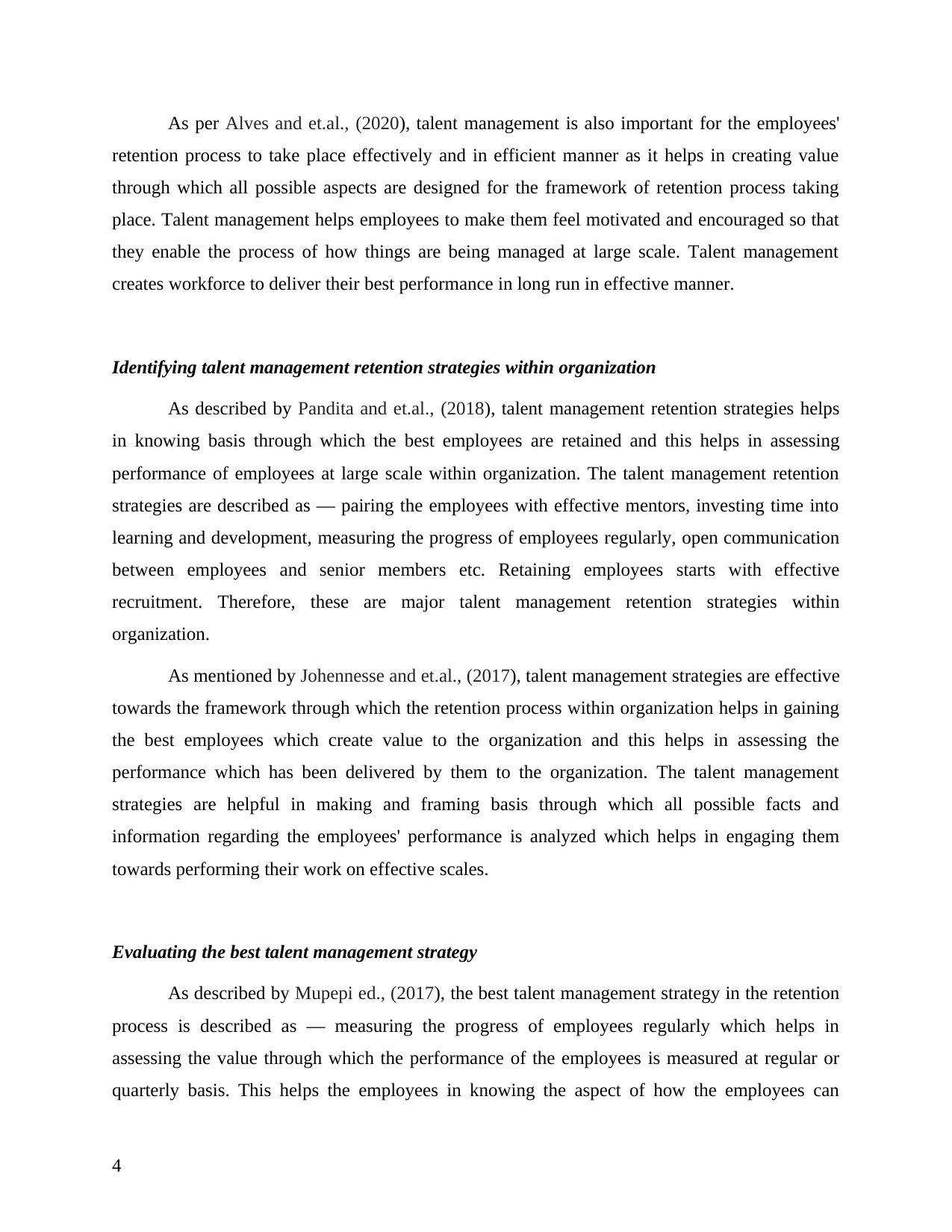
As per Alves and et.al., (2020), talent management is also important for the employees'
retention process to take place effectively and in efficient manner as it helps in creating value
through which all possible aspects are designed for the framework of retention process taking
place. Talent management helps employees to make them feel motivated and encouraged so that
they enable the process of how things are being managed at large scale. Talent management
creates workforce to deliver their best performance in long run in effective manner.
Identifying talent management retention strategies within organization
As described by Pandita and et.al., (2018), talent management retention strategies helps
in knowing basis through which the best employees are retained and this helps in assessing
performance of employees at large scale within organization. The talent management retention
strategies are described as — pairing the employees with effective mentors, investing time into
learning and development, measuring the progress of employees regularly, open communication
between employees and senior members etc. Retaining employees starts with effective
recruitment. Therefore, these are major talent management retention strategies within
organization.
As mentioned by Johennesse and et.al., (2017), talent management strategies are effective
towards the framework through which the retention process within organization helps in gaining
the best employees which create value to the organization and this helps in assessing the
performance which has been delivered by them to the organization. The talent management
strategies are helpful in making and framing basis through which all possible facts and
information regarding the employees' performance is analyzed which helps in engaging them
towards performing their work on effective scales.
Evaluating the best talent management strategy
As described by Mupepi ed., (2017), the best talent management strategy in the retention
process is described as — measuring the progress of employees regularly which helps in
assessing the value through which the performance of the employees is measured at regular or
quarterly basis. This helps the employees in knowing the aspect of how the employees can
4
retention process to take place effectively and in efficient manner as it helps in creating value
through which all possible aspects are designed for the framework of retention process taking
place. Talent management helps employees to make them feel motivated and encouraged so that
they enable the process of how things are being managed at large scale. Talent management
creates workforce to deliver their best performance in long run in effective manner.
Identifying talent management retention strategies within organization
As described by Pandita and et.al., (2018), talent management retention strategies helps
in knowing basis through which the best employees are retained and this helps in assessing
performance of employees at large scale within organization. The talent management retention
strategies are described as — pairing the employees with effective mentors, investing time into
learning and development, measuring the progress of employees regularly, open communication
between employees and senior members etc. Retaining employees starts with effective
recruitment. Therefore, these are major talent management retention strategies within
organization.
As mentioned by Johennesse and et.al., (2017), talent management strategies are effective
towards the framework through which the retention process within organization helps in gaining
the best employees which create value to the organization and this helps in assessing the
performance which has been delivered by them to the organization. The talent management
strategies are helpful in making and framing basis through which all possible facts and
information regarding the employees' performance is analyzed which helps in engaging them
towards performing their work on effective scales.
Evaluating the best talent management strategy
As described by Mupepi ed., (2017), the best talent management strategy in the retention
process is described as — measuring the progress of employees regularly which helps in
assessing the value through which the performance of the employees is measured at regular or
quarterly basis. This helps the employees in knowing the aspect of how the employees can
4
Secure Best Marks with AI Grader
Need help grading? Try our AI Grader for instant feedback on your assignments.
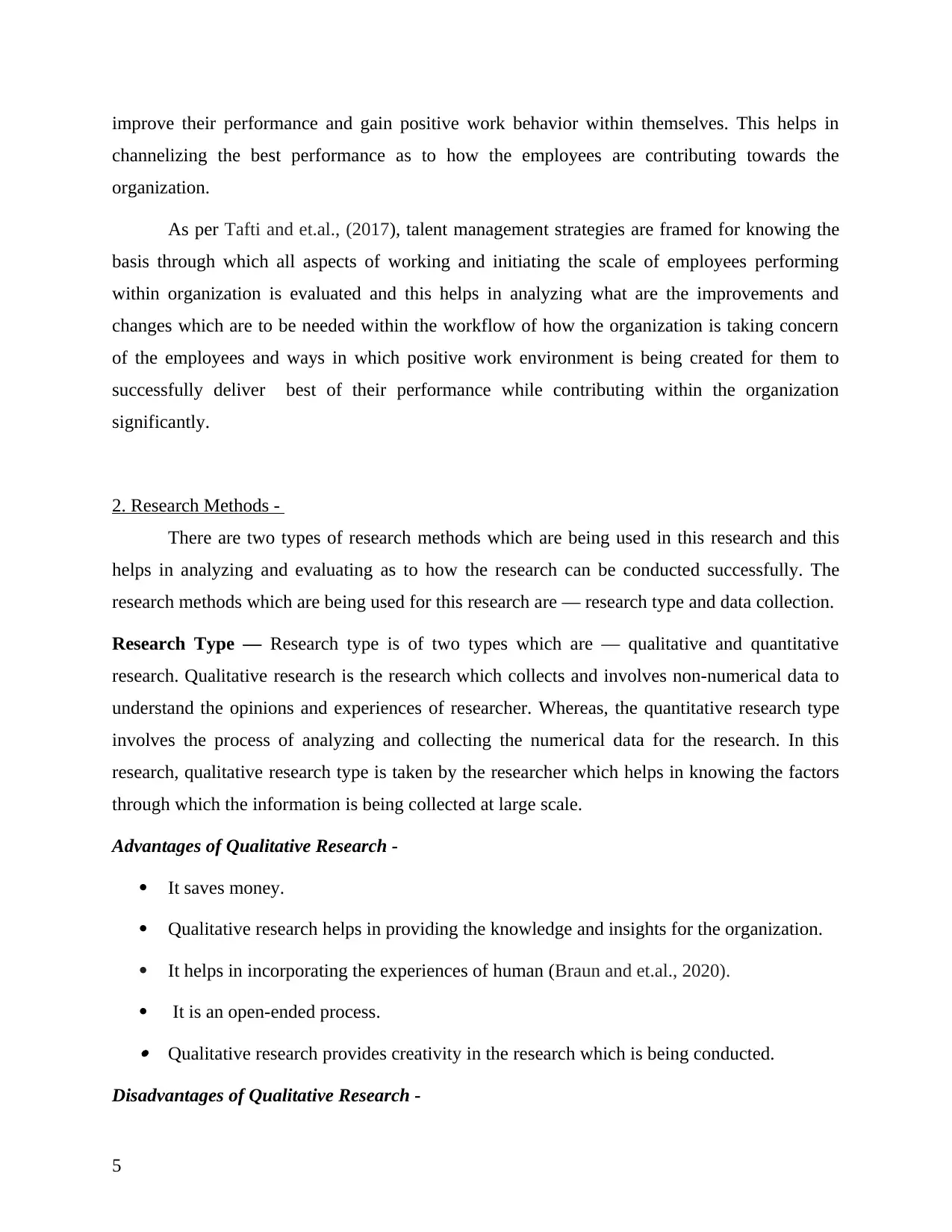
improve their performance and gain positive work behavior within themselves. This helps in
channelizing the best performance as to how the employees are contributing towards the
organization.
As per Tafti and et.al., (2017), talent management strategies are framed for knowing the
basis through which all aspects of working and initiating the scale of employees performing
within organization is evaluated and this helps in analyzing what are the improvements and
changes which are to be needed within the workflow of how the organization is taking concern
of the employees and ways in which positive work environment is being created for them to
successfully deliver best of their performance while contributing within the organization
significantly.
2. Research Methods -
There are two types of research methods which are being used in this research and this
helps in analyzing and evaluating as to how the research can be conducted successfully. The
research methods which are being used for this research are — research type and data collection.
Research Type — Research type is of two types which are — qualitative and quantitative
research. Qualitative research is the research which collects and involves non-numerical data to
understand the opinions and experiences of researcher. Whereas, the quantitative research type
involves the process of analyzing and collecting the numerical data for the research. In this
research, qualitative research type is taken by the researcher which helps in knowing the factors
through which the information is being collected at large scale.
Advantages of Qualitative Research -
It saves money.
Qualitative research helps in providing the knowledge and insights for the organization.
It helps in incorporating the experiences of human (Braun and et.al., 2020).
It is an open-ended process. Qualitative research provides creativity in the research which is being conducted.
Disadvantages of Qualitative Research -
5
channelizing the best performance as to how the employees are contributing towards the
organization.
As per Tafti and et.al., (2017), talent management strategies are framed for knowing the
basis through which all aspects of working and initiating the scale of employees performing
within organization is evaluated and this helps in analyzing what are the improvements and
changes which are to be needed within the workflow of how the organization is taking concern
of the employees and ways in which positive work environment is being created for them to
successfully deliver best of their performance while contributing within the organization
significantly.
2. Research Methods -
There are two types of research methods which are being used in this research and this
helps in analyzing and evaluating as to how the research can be conducted successfully. The
research methods which are being used for this research are — research type and data collection.
Research Type — Research type is of two types which are — qualitative and quantitative
research. Qualitative research is the research which collects and involves non-numerical data to
understand the opinions and experiences of researcher. Whereas, the quantitative research type
involves the process of analyzing and collecting the numerical data for the research. In this
research, qualitative research type is taken by the researcher which helps in knowing the factors
through which the information is being collected at large scale.
Advantages of Qualitative Research -
It saves money.
Qualitative research helps in providing the knowledge and insights for the organization.
It helps in incorporating the experiences of human (Braun and et.al., 2020).
It is an open-ended process. Qualitative research provides creativity in the research which is being conducted.
Disadvantages of Qualitative Research -
5
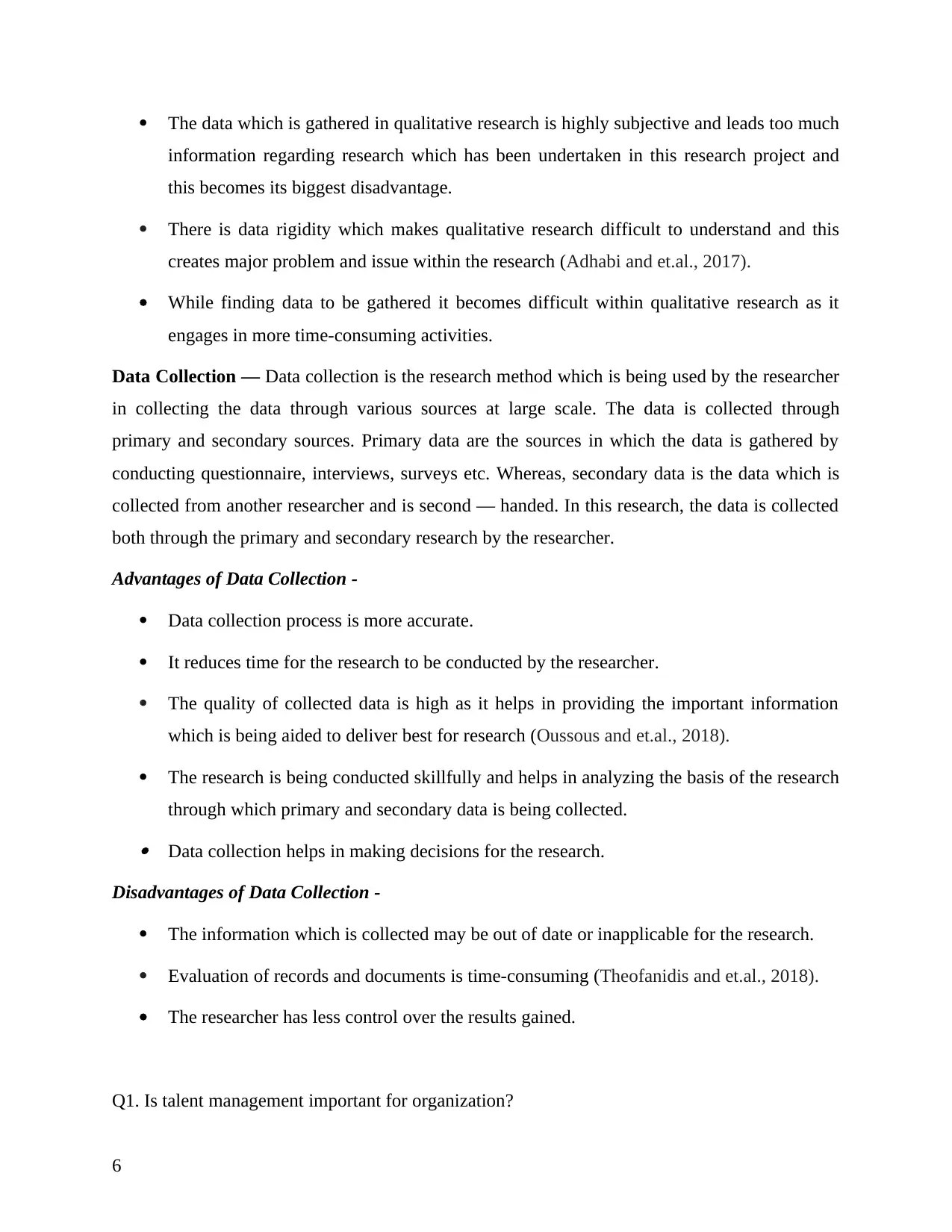
The data which is gathered in qualitative research is highly subjective and leads too much
information regarding research which has been undertaken in this research project and
this becomes its biggest disadvantage.
There is data rigidity which makes qualitative research difficult to understand and this
creates major problem and issue within the research (Adhabi and et.al., 2017).
While finding data to be gathered it becomes difficult within qualitative research as it
engages in more time-consuming activities.
Data Collection — Data collection is the research method which is being used by the researcher
in collecting the data through various sources at large scale. The data is collected through
primary and secondary sources. Primary data are the sources in which the data is gathered by
conducting questionnaire, interviews, surveys etc. Whereas, secondary data is the data which is
collected from another researcher and is second — handed. In this research, the data is collected
both through the primary and secondary research by the researcher.
Advantages of Data Collection -
Data collection process is more accurate.
It reduces time for the research to be conducted by the researcher.
The quality of collected data is high as it helps in providing the important information
which is being aided to deliver best for research (Oussous and et.al., 2018).
The research is being conducted skillfully and helps in analyzing the basis of the research
through which primary and secondary data is being collected. Data collection helps in making decisions for the research.
Disadvantages of Data Collection -
The information which is collected may be out of date or inapplicable for the research.
Evaluation of records and documents is time-consuming (Theofanidis and et.al., 2018).
The researcher has less control over the results gained.
Q1. Is talent management important for organization?
6
information regarding research which has been undertaken in this research project and
this becomes its biggest disadvantage.
There is data rigidity which makes qualitative research difficult to understand and this
creates major problem and issue within the research (Adhabi and et.al., 2017).
While finding data to be gathered it becomes difficult within qualitative research as it
engages in more time-consuming activities.
Data Collection — Data collection is the research method which is being used by the researcher
in collecting the data through various sources at large scale. The data is collected through
primary and secondary sources. Primary data are the sources in which the data is gathered by
conducting questionnaire, interviews, surveys etc. Whereas, secondary data is the data which is
collected from another researcher and is second — handed. In this research, the data is collected
both through the primary and secondary research by the researcher.
Advantages of Data Collection -
Data collection process is more accurate.
It reduces time for the research to be conducted by the researcher.
The quality of collected data is high as it helps in providing the important information
which is being aided to deliver best for research (Oussous and et.al., 2018).
The research is being conducted skillfully and helps in analyzing the basis of the research
through which primary and secondary data is being collected. Data collection helps in making decisions for the research.
Disadvantages of Data Collection -
The information which is collected may be out of date or inapplicable for the research.
Evaluation of records and documents is time-consuming (Theofanidis and et.al., 2018).
The researcher has less control over the results gained.
Q1. Is talent management important for organization?
6
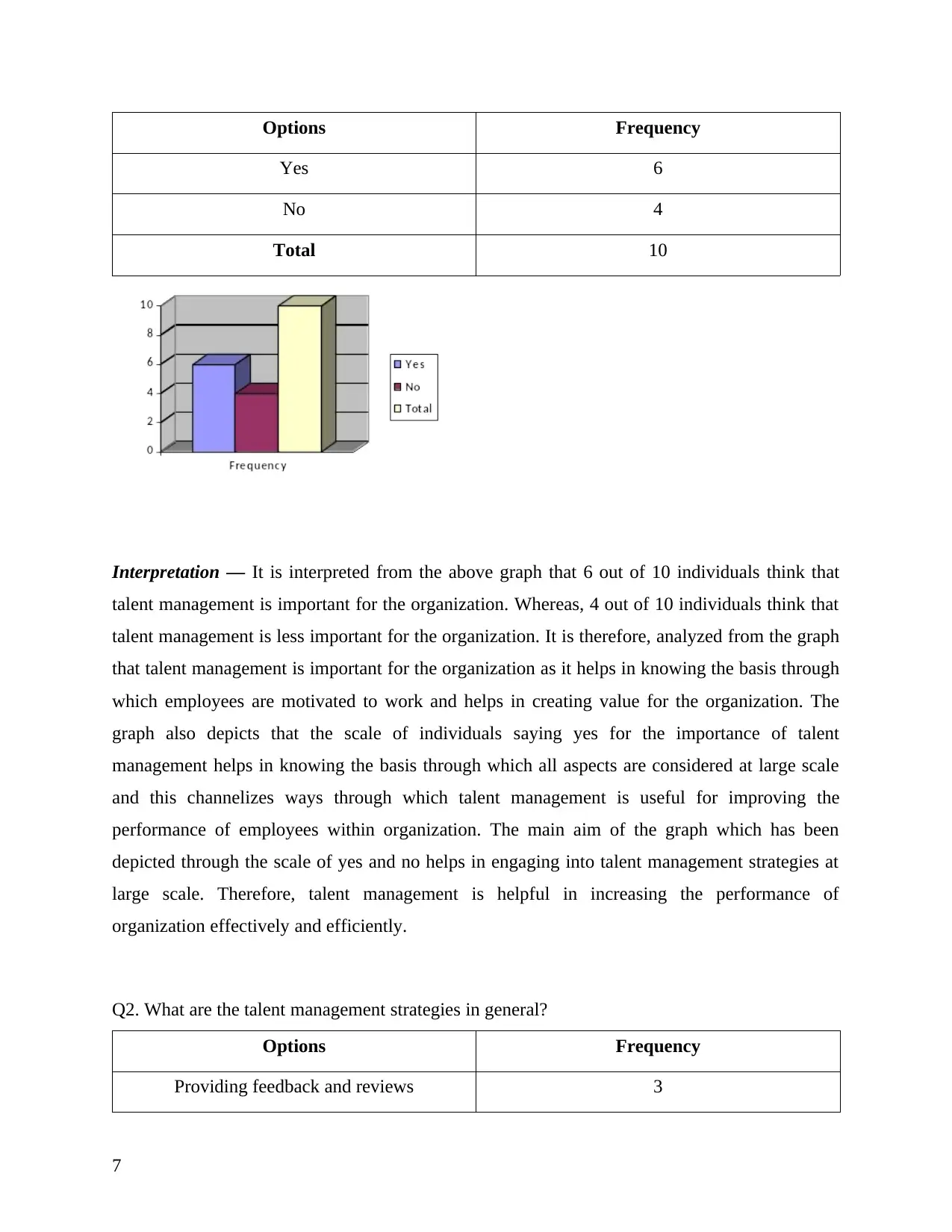
Options Frequency
Yes 6
No 4
Total 10
Interpretation — It is interpreted from the above graph that 6 out of 10 individuals think that
talent management is important for the organization. Whereas, 4 out of 10 individuals think that
talent management is less important for the organization. It is therefore, analyzed from the graph
that talent management is important for the organization as it helps in knowing the basis through
which employees are motivated to work and helps in creating value for the organization. The
graph also depicts that the scale of individuals saying yes for the importance of talent
management helps in knowing the basis through which all aspects are considered at large scale
and this channelizes ways through which talent management is useful for improving the
performance of employees within organization. The main aim of the graph which has been
depicted through the scale of yes and no helps in engaging into talent management strategies at
large scale. Therefore, talent management is helpful in increasing the performance of
organization effectively and efficiently.
Q2. What are the talent management strategies in general?
Options Frequency
Providing feedback and reviews 3
7
Yes 6
No 4
Total 10
Interpretation — It is interpreted from the above graph that 6 out of 10 individuals think that
talent management is important for the organization. Whereas, 4 out of 10 individuals think that
talent management is less important for the organization. It is therefore, analyzed from the graph
that talent management is important for the organization as it helps in knowing the basis through
which employees are motivated to work and helps in creating value for the organization. The
graph also depicts that the scale of individuals saying yes for the importance of talent
management helps in knowing the basis through which all aspects are considered at large scale
and this channelizes ways through which talent management is useful for improving the
performance of employees within organization. The main aim of the graph which has been
depicted through the scale of yes and no helps in engaging into talent management strategies at
large scale. Therefore, talent management is helpful in increasing the performance of
organization effectively and efficiently.
Q2. What are the talent management strategies in general?
Options Frequency
Providing feedback and reviews 3
7
Paraphrase This Document
Need a fresh take? Get an instant paraphrase of this document with our AI Paraphraser
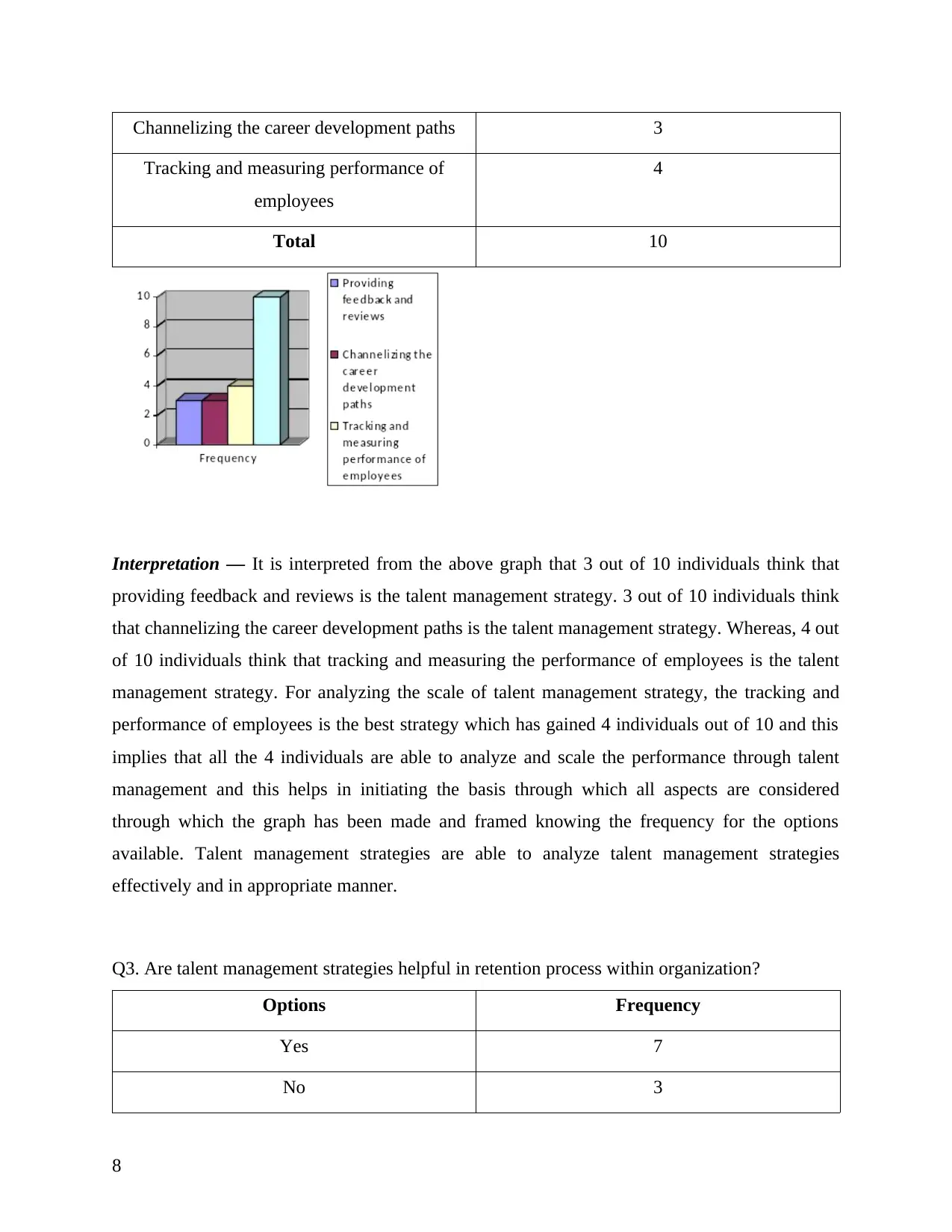
Channelizing the career development paths 3
Tracking and measuring performance of
employees
4
Total 10
Interpretation — It is interpreted from the above graph that 3 out of 10 individuals think that
providing feedback and reviews is the talent management strategy. 3 out of 10 individuals think
that channelizing the career development paths is the talent management strategy. Whereas, 4 out
of 10 individuals think that tracking and measuring the performance of employees is the talent
management strategy. For analyzing the scale of talent management strategy, the tracking and
performance of employees is the best strategy which has gained 4 individuals out of 10 and this
implies that all the 4 individuals are able to analyze and scale the performance through talent
management and this helps in initiating the basis through which all aspects are considered
through which the graph has been made and framed knowing the frequency for the options
available. Talent management strategies are able to analyze talent management strategies
effectively and in appropriate manner.
Q3. Are talent management strategies helpful in retention process within organization?
Options Frequency
Yes 7
No 3
8
Tracking and measuring performance of
employees
4
Total 10
Interpretation — It is interpreted from the above graph that 3 out of 10 individuals think that
providing feedback and reviews is the talent management strategy. 3 out of 10 individuals think
that channelizing the career development paths is the talent management strategy. Whereas, 4 out
of 10 individuals think that tracking and measuring the performance of employees is the talent
management strategy. For analyzing the scale of talent management strategy, the tracking and
performance of employees is the best strategy which has gained 4 individuals out of 10 and this
implies that all the 4 individuals are able to analyze and scale the performance through talent
management and this helps in initiating the basis through which all aspects are considered
through which the graph has been made and framed knowing the frequency for the options
available. Talent management strategies are able to analyze talent management strategies
effectively and in appropriate manner.
Q3. Are talent management strategies helpful in retention process within organization?
Options Frequency
Yes 7
No 3
8
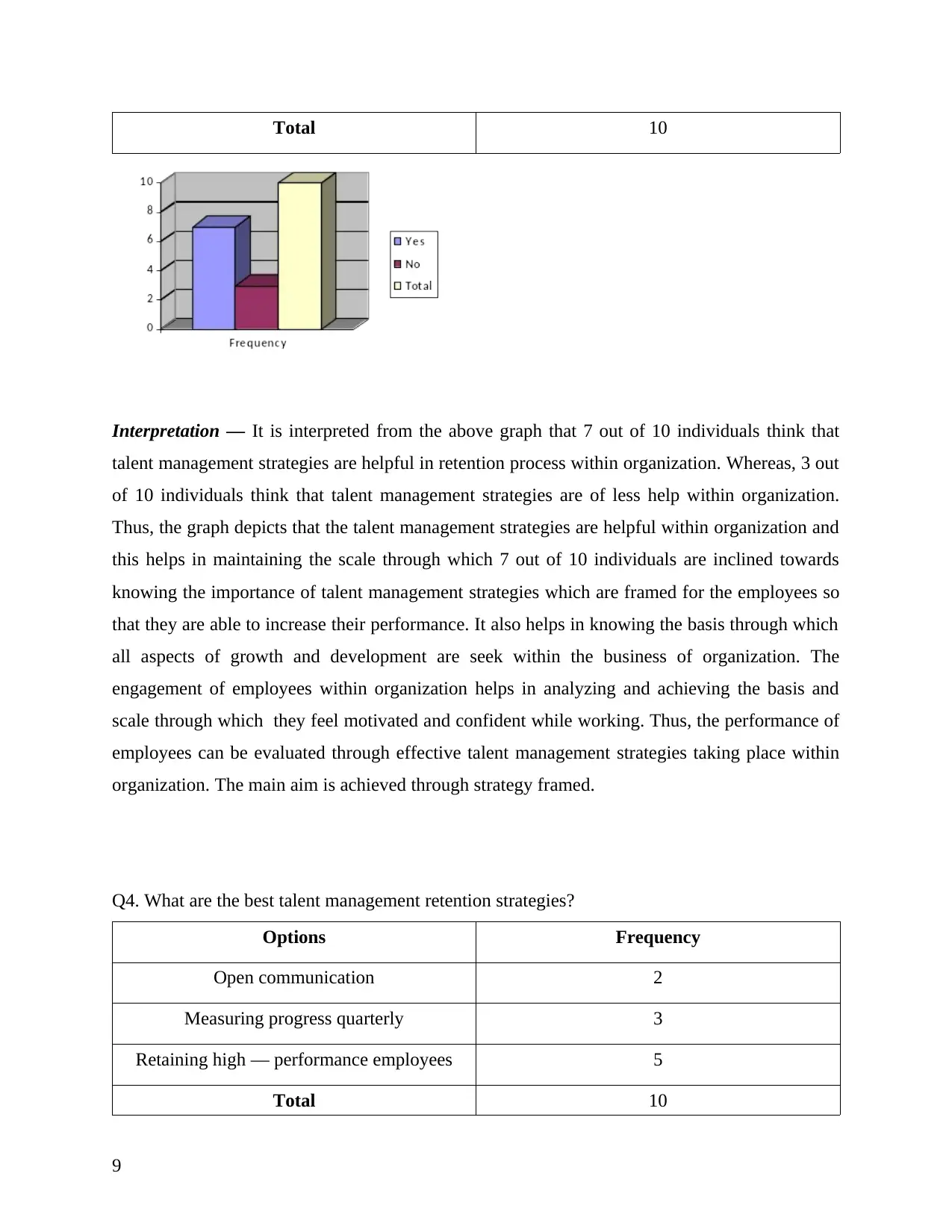
Total 10
Interpretation — It is interpreted from the above graph that 7 out of 10 individuals think that
talent management strategies are helpful in retention process within organization. Whereas, 3 out
of 10 individuals think that talent management strategies are of less help within organization.
Thus, the graph depicts that the talent management strategies are helpful within organization and
this helps in maintaining the scale through which 7 out of 10 individuals are inclined towards
knowing the importance of talent management strategies which are framed for the employees so
that they are able to increase their performance. It also helps in knowing the basis through which
all aspects of growth and development are seek within the business of organization. The
engagement of employees within organization helps in analyzing and achieving the basis and
scale through which they feel motivated and confident while working. Thus, the performance of
employees can be evaluated through effective talent management strategies taking place within
organization. The main aim is achieved through strategy framed.
Q4. What are the best talent management retention strategies?
Options Frequency
Open communication 2
Measuring progress quarterly 3
Retaining high — performance employees 5
Total 10
9
Interpretation — It is interpreted from the above graph that 7 out of 10 individuals think that
talent management strategies are helpful in retention process within organization. Whereas, 3 out
of 10 individuals think that talent management strategies are of less help within organization.
Thus, the graph depicts that the talent management strategies are helpful within organization and
this helps in maintaining the scale through which 7 out of 10 individuals are inclined towards
knowing the importance of talent management strategies which are framed for the employees so
that they are able to increase their performance. It also helps in knowing the basis through which
all aspects of growth and development are seek within the business of organization. The
engagement of employees within organization helps in analyzing and achieving the basis and
scale through which they feel motivated and confident while working. Thus, the performance of
employees can be evaluated through effective talent management strategies taking place within
organization. The main aim is achieved through strategy framed.
Q4. What are the best talent management retention strategies?
Options Frequency
Open communication 2
Measuring progress quarterly 3
Retaining high — performance employees 5
Total 10
9
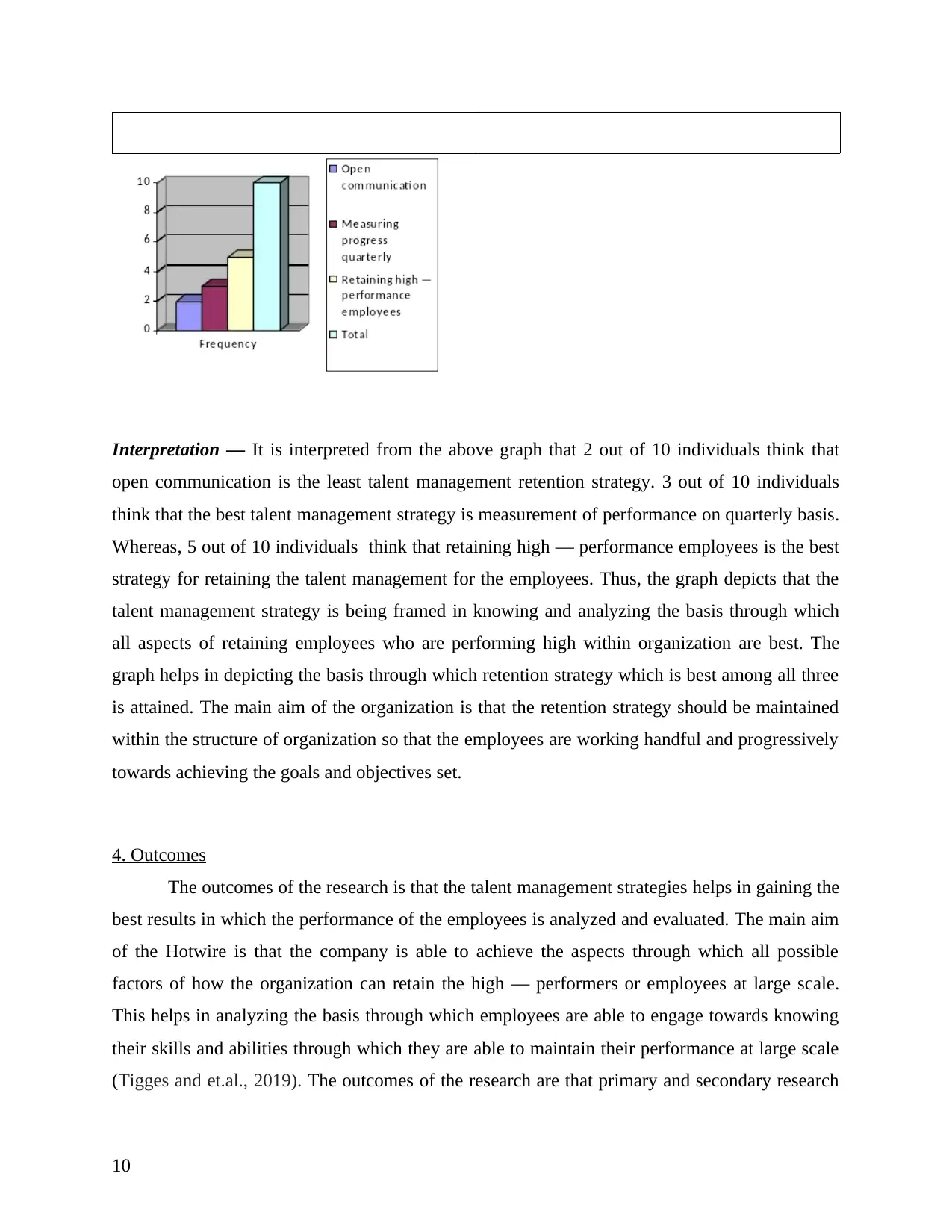
Interpretation — It is interpreted from the above graph that 2 out of 10 individuals think that
open communication is the least talent management retention strategy. 3 out of 10 individuals
think that the best talent management strategy is measurement of performance on quarterly basis.
Whereas, 5 out of 10 individuals think that retaining high — performance employees is the best
strategy for retaining the talent management for the employees. Thus, the graph depicts that the
talent management strategy is being framed in knowing and analyzing the basis through which
all aspects of retaining employees who are performing high within organization are best. The
graph helps in depicting the basis through which retention strategy which is best among all three
is attained. The main aim of the organization is that the retention strategy should be maintained
within the structure of organization so that the employees are working handful and progressively
towards achieving the goals and objectives set.
4. Outcomes
The outcomes of the research is that the talent management strategies helps in gaining the
best results in which the performance of the employees is analyzed and evaluated. The main aim
of the Hotwire is that the company is able to achieve the aspects through which all possible
factors of how the organization can retain the high — performers or employees at large scale.
This helps in analyzing the basis through which employees are able to engage towards knowing
their skills and abilities through which they are able to maintain their performance at large scale
(Tigges and et.al., 2019). The outcomes of the research are that primary and secondary research
10
open communication is the least talent management retention strategy. 3 out of 10 individuals
think that the best talent management strategy is measurement of performance on quarterly basis.
Whereas, 5 out of 10 individuals think that retaining high — performance employees is the best
strategy for retaining the talent management for the employees. Thus, the graph depicts that the
talent management strategy is being framed in knowing and analyzing the basis through which
all aspects of retaining employees who are performing high within organization are best. The
graph helps in depicting the basis through which retention strategy which is best among all three
is attained. The main aim of the organization is that the retention strategy should be maintained
within the structure of organization so that the employees are working handful and progressively
towards achieving the goals and objectives set.
4. Outcomes
The outcomes of the research is that the talent management strategies helps in gaining the
best results in which the performance of the employees is analyzed and evaluated. The main aim
of the Hotwire is that the company is able to achieve the aspects through which all possible
factors of how the organization can retain the high — performers or employees at large scale.
This helps in analyzing the basis through which employees are able to engage towards knowing
their skills and abilities through which they are able to maintain their performance at large scale
(Tigges and et.al., 2019). The outcomes of the research are that primary and secondary research
10
Secure Best Marks with AI Grader
Need help grading? Try our AI Grader for instant feedback on your assignments.
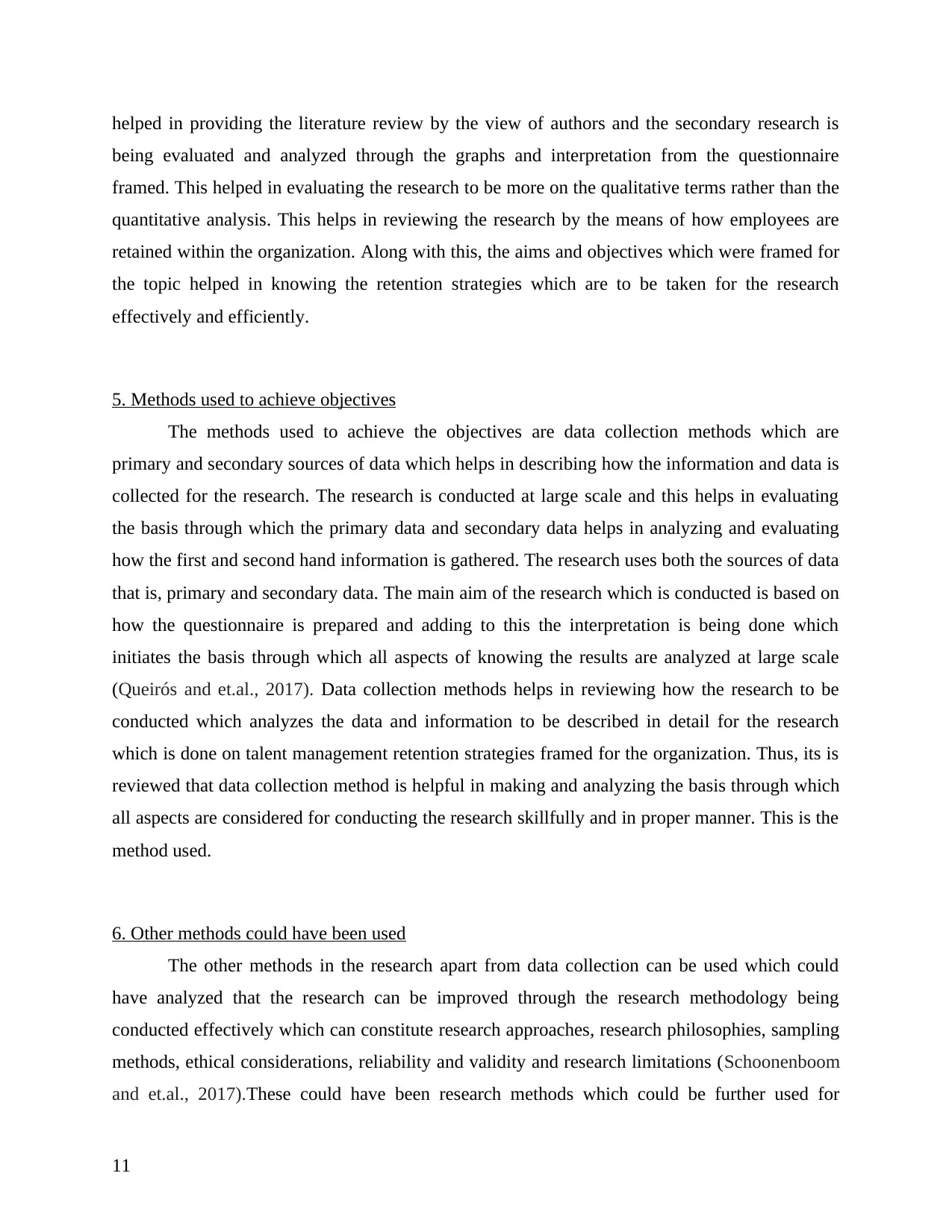
helped in providing the literature review by the view of authors and the secondary research is
being evaluated and analyzed through the graphs and interpretation from the questionnaire
framed. This helped in evaluating the research to be more on the qualitative terms rather than the
quantitative analysis. This helps in reviewing the research by the means of how employees are
retained within the organization. Along with this, the aims and objectives which were framed for
the topic helped in knowing the retention strategies which are to be taken for the research
effectively and efficiently.
5. Methods used to achieve objectives
The methods used to achieve the objectives are data collection methods which are
primary and secondary sources of data which helps in describing how the information and data is
collected for the research. The research is conducted at large scale and this helps in evaluating
the basis through which the primary data and secondary data helps in analyzing and evaluating
how the first and second hand information is gathered. The research uses both the sources of data
that is, primary and secondary data. The main aim of the research which is conducted is based on
how the questionnaire is prepared and adding to this the interpretation is being done which
initiates the basis through which all aspects of knowing the results are analyzed at large scale
(Queirós and et.al., 2017). Data collection methods helps in reviewing how the research to be
conducted which analyzes the data and information to be described in detail for the research
which is done on talent management retention strategies framed for the organization. Thus, its is
reviewed that data collection method is helpful in making and analyzing the basis through which
all aspects are considered for conducting the research skillfully and in proper manner. This is the
method used.
6. Other methods could have been used
The other methods in the research apart from data collection can be used which could
have analyzed that the research can be improved through the research methodology being
conducted effectively which can constitute research approaches, research philosophies, sampling
methods, ethical considerations, reliability and validity and research limitations (Schoonenboom
and et.al., 2017).These could have been research methods which could be further used for
11
being evaluated and analyzed through the graphs and interpretation from the questionnaire
framed. This helped in evaluating the research to be more on the qualitative terms rather than the
quantitative analysis. This helps in reviewing the research by the means of how employees are
retained within the organization. Along with this, the aims and objectives which were framed for
the topic helped in knowing the retention strategies which are to be taken for the research
effectively and efficiently.
5. Methods used to achieve objectives
The methods used to achieve the objectives are data collection methods which are
primary and secondary sources of data which helps in describing how the information and data is
collected for the research. The research is conducted at large scale and this helps in evaluating
the basis through which the primary data and secondary data helps in analyzing and evaluating
how the first and second hand information is gathered. The research uses both the sources of data
that is, primary and secondary data. The main aim of the research which is conducted is based on
how the questionnaire is prepared and adding to this the interpretation is being done which
initiates the basis through which all aspects of knowing the results are analyzed at large scale
(Queirós and et.al., 2017). Data collection methods helps in reviewing how the research to be
conducted which analyzes the data and information to be described in detail for the research
which is done on talent management retention strategies framed for the organization. Thus, its is
reviewed that data collection method is helpful in making and analyzing the basis through which
all aspects are considered for conducting the research skillfully and in proper manner. This is the
method used.
6. Other methods could have been used
The other methods in the research apart from data collection can be used which could
have analyzed that the research can be improved through the research methodology being
conducted effectively which can constitute research approaches, research philosophies, sampling
methods, ethical considerations, reliability and validity and research limitations (Schoonenboom
and et.al., 2017).These could have been research methods which could be further used for
11
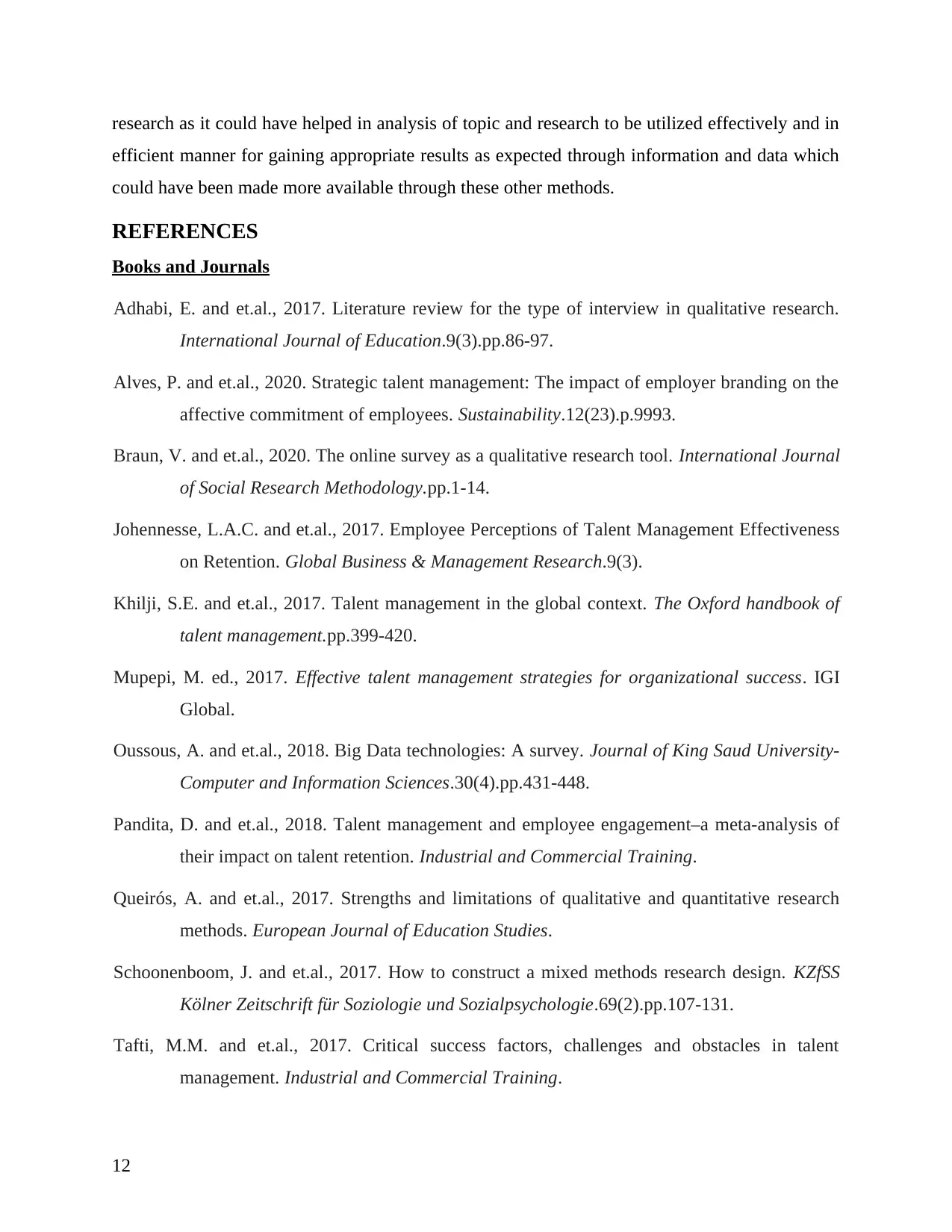
research as it could have helped in analysis of topic and research to be utilized effectively and in
efficient manner for gaining appropriate results as expected through information and data which
could have been made more available through these other methods.
REFERENCES
Books and Journals
Adhabi, E. and et.al., 2017. Literature review for the type of interview in qualitative research.
International Journal of Education.9(3).pp.86-97.
Alves, P. and et.al., 2020. Strategic talent management: The impact of employer branding on the
affective commitment of employees. Sustainability.12(23).p.9993.
Braun, V. and et.al., 2020. The online survey as a qualitative research tool. International Journal
of Social Research Methodology.pp.1-14.
Johennesse, L.A.C. and et.al., 2017. Employee Perceptions of Talent Management Effectiveness
on Retention. Global Business & Management Research.9(3).
Khilji, S.E. and et.al., 2017. Talent management in the global context. The Oxford handbook of
talent management.pp.399-420.
Mupepi, M. ed., 2017. Effective talent management strategies for organizational success. IGI
Global.
Oussous, A. and et.al., 2018. Big Data technologies: A survey. Journal of King Saud University-
Computer and Information Sciences.30(4).pp.431-448.
Pandita, D. and et.al., 2018. Talent management and employee engagement–a meta-analysis of
their impact on talent retention. Industrial and Commercial Training.
Queirós, A. and et.al., 2017. Strengths and limitations of qualitative and quantitative research
methods. European Journal of Education Studies.
Schoonenboom, J. and et.al., 2017. How to construct a mixed methods research design. KZfSS
Kölner Zeitschrift für Soziologie und Sozialpsychologie.69(2).pp.107-131.
Tafti, M.M. and et.al., 2017. Critical success factors, challenges and obstacles in talent
management. Industrial and Commercial Training.
12
efficient manner for gaining appropriate results as expected through information and data which
could have been made more available through these other methods.
REFERENCES
Books and Journals
Adhabi, E. and et.al., 2017. Literature review for the type of interview in qualitative research.
International Journal of Education.9(3).pp.86-97.
Alves, P. and et.al., 2020. Strategic talent management: The impact of employer branding on the
affective commitment of employees. Sustainability.12(23).p.9993.
Braun, V. and et.al., 2020. The online survey as a qualitative research tool. International Journal
of Social Research Methodology.pp.1-14.
Johennesse, L.A.C. and et.al., 2017. Employee Perceptions of Talent Management Effectiveness
on Retention. Global Business & Management Research.9(3).
Khilji, S.E. and et.al., 2017. Talent management in the global context. The Oxford handbook of
talent management.pp.399-420.
Mupepi, M. ed., 2017. Effective talent management strategies for organizational success. IGI
Global.
Oussous, A. and et.al., 2018. Big Data technologies: A survey. Journal of King Saud University-
Computer and Information Sciences.30(4).pp.431-448.
Pandita, D. and et.al., 2018. Talent management and employee engagement–a meta-analysis of
their impact on talent retention. Industrial and Commercial Training.
Queirós, A. and et.al., 2017. Strengths and limitations of qualitative and quantitative research
methods. European Journal of Education Studies.
Schoonenboom, J. and et.al., 2017. How to construct a mixed methods research design. KZfSS
Kölner Zeitschrift für Soziologie und Sozialpsychologie.69(2).pp.107-131.
Tafti, M.M. and et.al., 2017. Critical success factors, challenges and obstacles in talent
management. Industrial and Commercial Training.
12
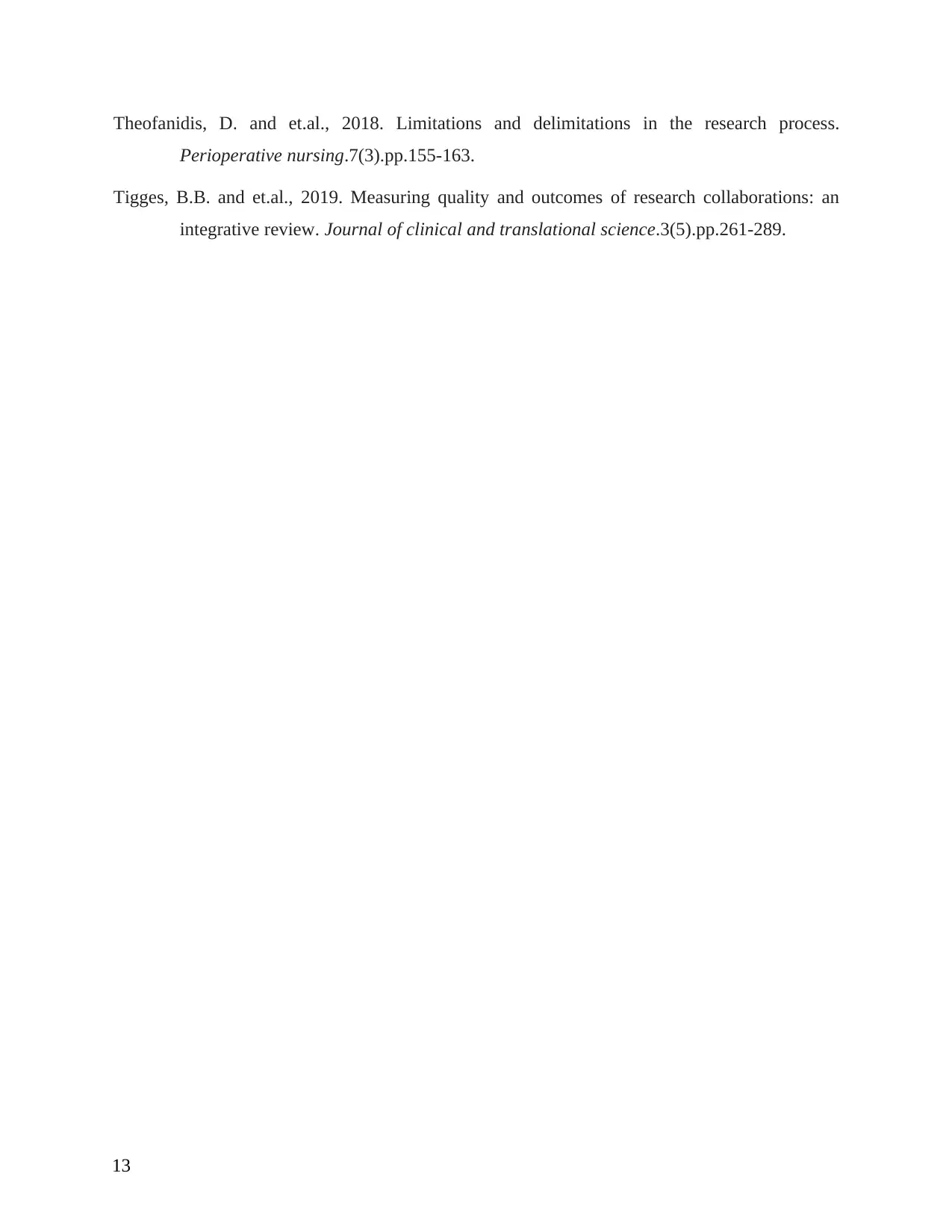
Theofanidis, D. and et.al., 2018. Limitations and delimitations in the research process.
Perioperative nursing.7(3).pp.155-163.
Tigges, B.B. and et.al., 2019. Measuring quality and outcomes of research collaborations: an
integrative review. Journal of clinical and translational science.3(5).pp.261-289.
13
Perioperative nursing.7(3).pp.155-163.
Tigges, B.B. and et.al., 2019. Measuring quality and outcomes of research collaborations: an
integrative review. Journal of clinical and translational science.3(5).pp.261-289.
13
Paraphrase This Document
Need a fresh take? Get an instant paraphrase of this document with our AI Paraphraser
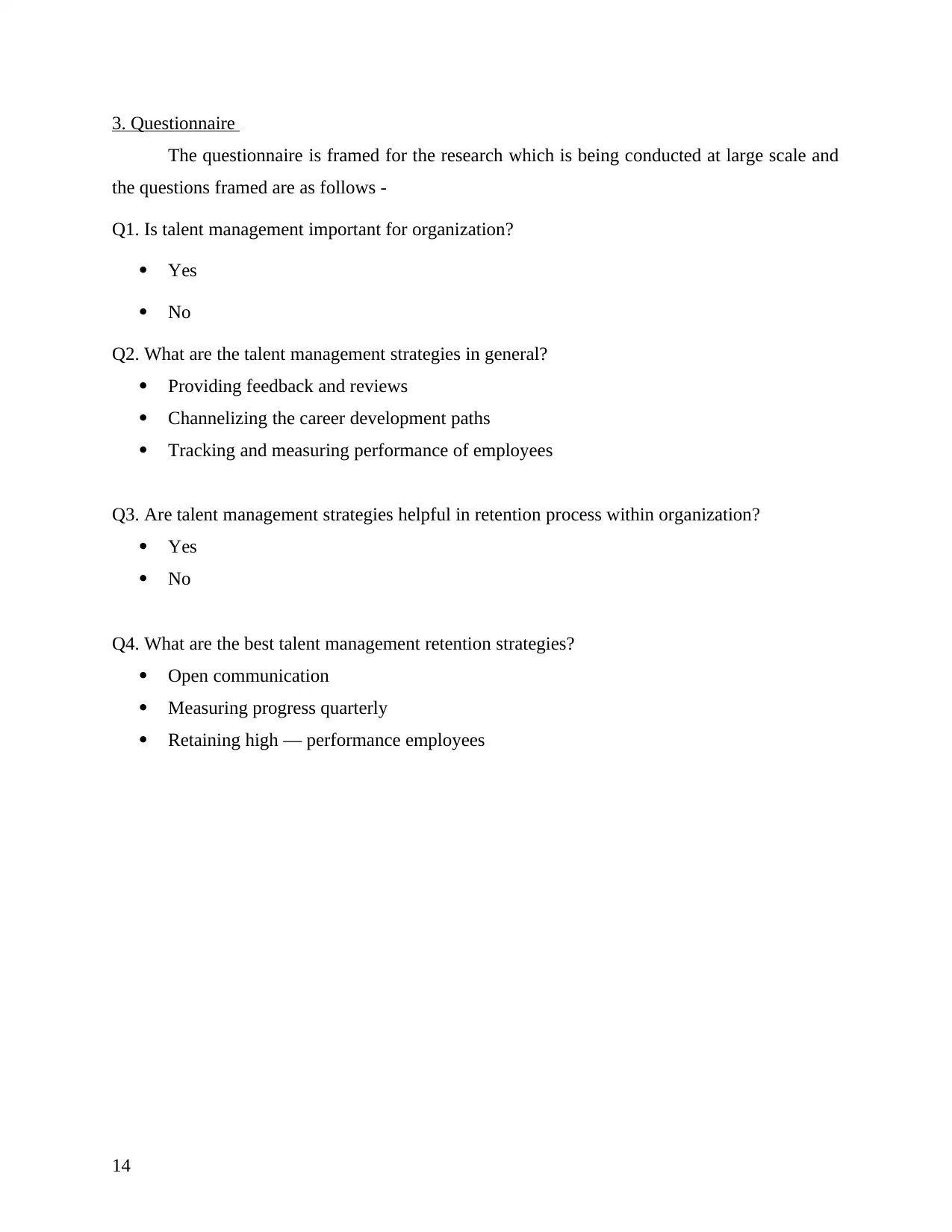
3. Questionnaire
The questionnaire is framed for the research which is being conducted at large scale and
the questions framed are as follows -
Q1. Is talent management important for organization?
Yes
No
Q2. What are the talent management strategies in general?
Providing feedback and reviews
Channelizing the career development paths
Tracking and measuring performance of employees
Q3. Are talent management strategies helpful in retention process within organization?
Yes
No
Q4. What are the best talent management retention strategies?
Open communication
Measuring progress quarterly
Retaining high — performance employees
14
The questionnaire is framed for the research which is being conducted at large scale and
the questions framed are as follows -
Q1. Is talent management important for organization?
Yes
No
Q2. What are the talent management strategies in general?
Providing feedback and reviews
Channelizing the career development paths
Tracking and measuring performance of employees
Q3. Are talent management strategies helpful in retention process within organization?
Yes
No
Q4. What are the best talent management retention strategies?
Open communication
Measuring progress quarterly
Retaining high — performance employees
14
1 out of 14
Related Documents
Your All-in-One AI-Powered Toolkit for Academic Success.
+13062052269
info@desklib.com
Available 24*7 on WhatsApp / Email
![[object Object]](/_next/static/media/star-bottom.7253800d.svg)
Unlock your academic potential
© 2024 | Zucol Services PVT LTD | All rights reserved.




